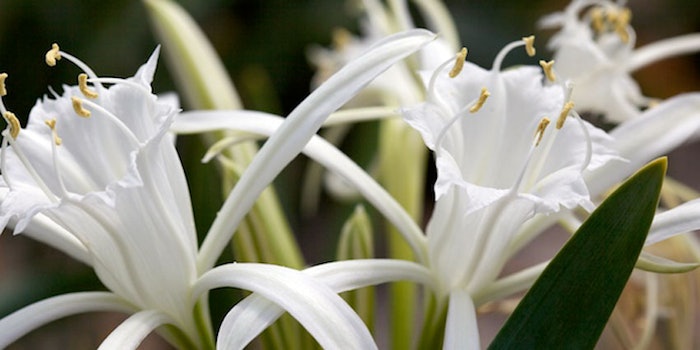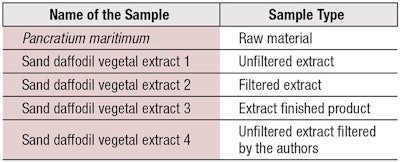
For the complete article, click through to the July/August 2019 digital edition.
Sand daffodil, or Pancratium maritimum, is an interesting perennial plant native to sandy coastal habitats.1 At one time, it most likely colonized the Mediterranean coast from Asia. P. maritimum is a monocotyledonous plant belonging to the Amaryllidaceae family2 that is cultivated in Europe or America mainly for ornamental purposes.3
P. maritimum has been the subject of diverse research, particularly in fundamental sciences including abiotic stress tolerance, plant physiology or genetic diversity.4-7 It also has been examined by the chemical field for the large number of alkaloids present in its bulb and leaf extracts.8, 9 These molecules are important for their pharmacological properties such as analgesic, anti-viral or anti-tumor.8, 10 In addition, P. maritimum is studied for its phenolic acid and flavonoid content9, 11—compounds used for their virtues as antioxidants.12
For cosmetic applications, an extract developed from the aerial parts of P. maritimum cultivated in greenhousesa has demonstrated anti-melanogenesis activity in cultivated human melanocytes and in vivo, in Asian volunteers living in Bangkok; specifically, a reduction in pigmentary spots was observed after 84 days of treatment.13 Similarly, Clarins Laboratories presented work on the anti-melanogenesis activity of P. maritimum through the regulation of melanosome transport.14
Like many botanical constituents, the active molecules in P. maritimum can be extracted using different techniques such as extraction in water alone; in a mix of water and ethanol; in water and glycerin; in water and glycols; at room temperature or higher temperatures; using lipidic solvents; or using supercritical fluids, i.e., water or CO2. Each method of extraction serves a purpose to derive a desired composition and activity—but also can modify or alter the plant DNA.
Moreover, in addition to preventing fraudulent or adulterated extracts, exact botanical identifications are important for appropriate use, future plant conservation and sustainable utilization. To this end, products and raw materials are currently investigated by the genetic techniques of barcoding and metabarcoding, in addition to chemical analyses.
The aim of the present study was to follow a plant extraction process chain and assess if and where, in the extraction process, the DNA identity of plant materials is lost. The authors first focused on authenticating P. maritimum species in raw materials. Next, they explored the traceability between plant raw materials and different filtrated extracts. Throughout the investigation, they utilized the technologies of barcoding, metabarcoding and bio-informatics analysis.
Materials and Methods
Plant materials: Five samples were analyzed in this study (see Table 1). These included the raw P. maritimum material, an unfiltered extract, a filtered extract, a finished extract product and an unfiltered extract that was filtered by the authors.












